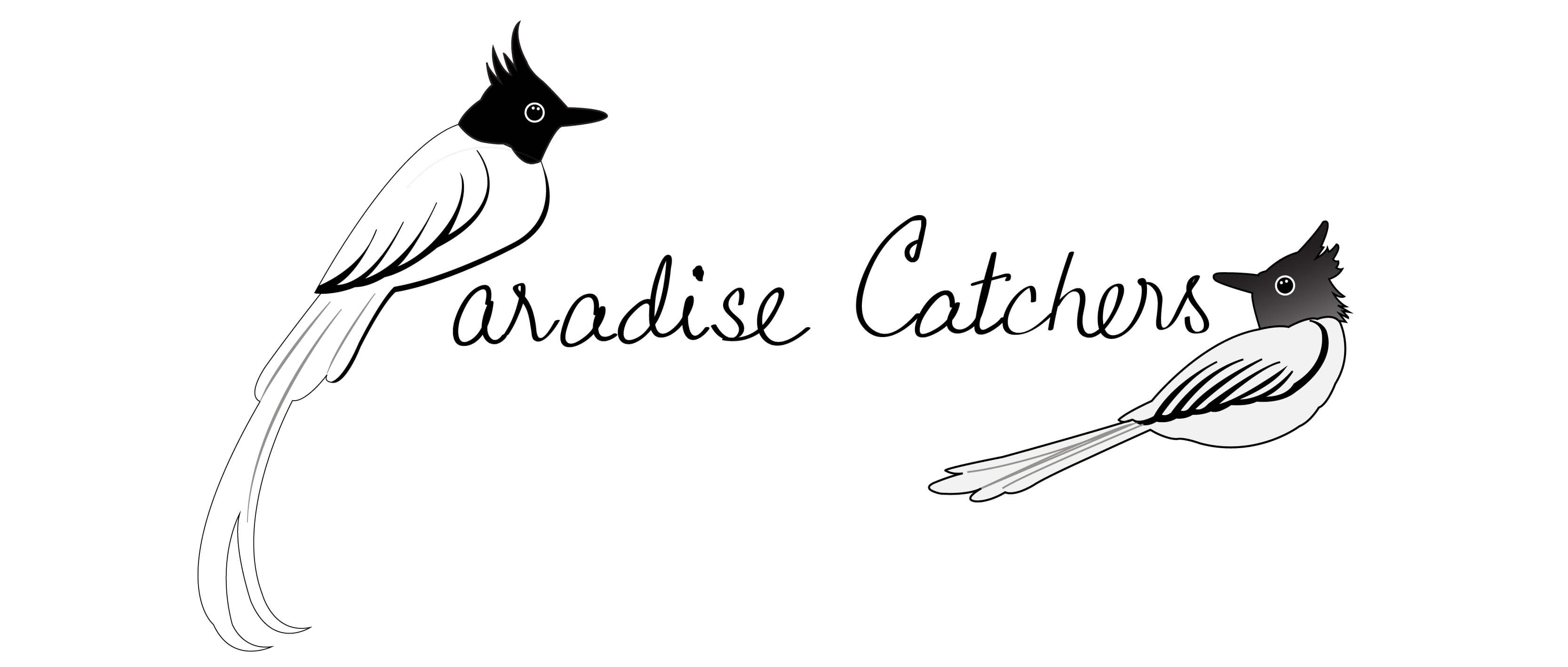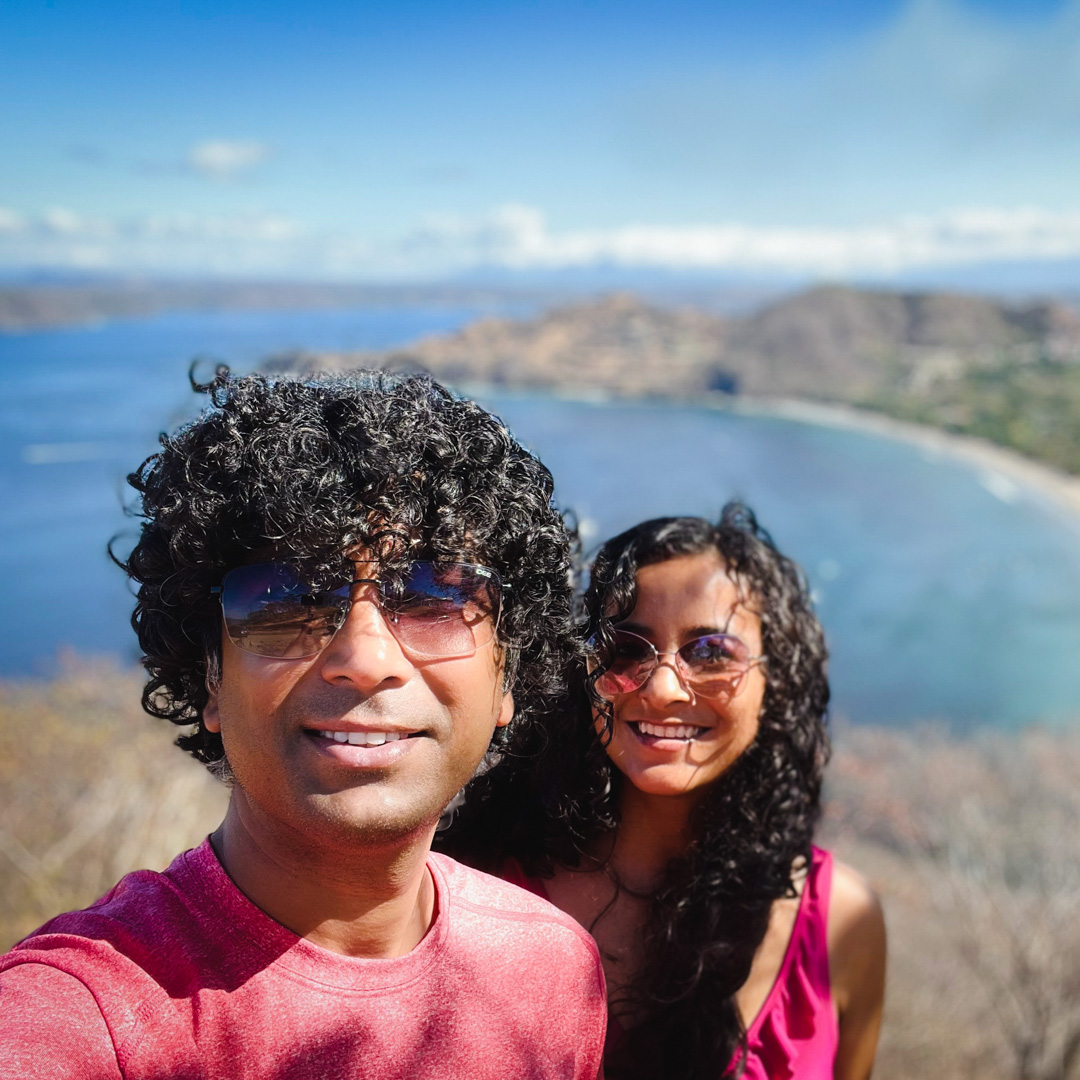Mexico City, the bustling capital of Mexico, with more than 20 million inhabitants, is one of the largest cities in the world. From ancient ruins to museums and murals, from early morning cycling to vibrant nightlife, from local markets to swanky upscale neighborhoods and the never ending flow of tequila and tacos, this city has something to offer to every kind of traveler. Whether you are in the city for a few days or even for a few months, you will never run out of things to do in Mexico City!
For us, Mexico City feels like home. With its beautiful juxtaposition of history and modernity, appreciation of various art forms and love for tantalizing street food, the resemblance with our city back in India is uncanny. On busy work days, despite navigating the chaotic traffic, people in Mexico City find joy in fine arts and flavorful food. Just like back home.
Even after several trips over the years, we keep returning to Mexico City and crave to come back every time it is time to leave.
In this Mexico City travel guide, we share with you ideas on what to do and other travel planning logistics. We will also address the most asked question, that is, whether it is safe to travel here.
As Amazon Associate we earn from qualifying purchases. Thanks for supporting Paradise Catchers.
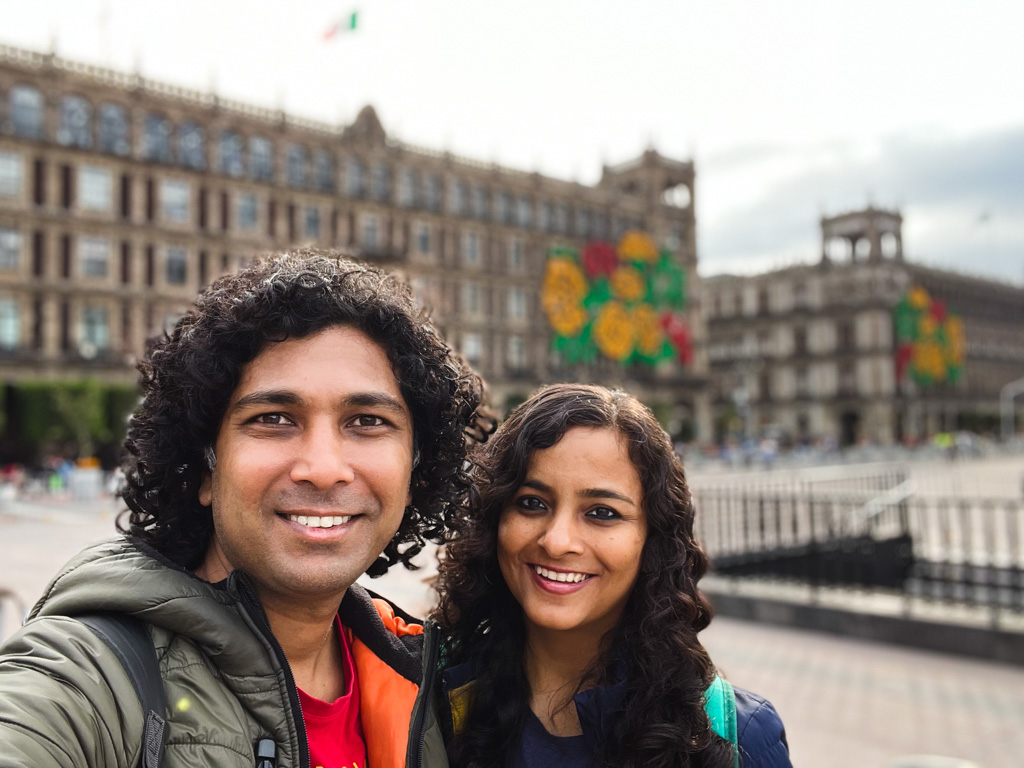
Things to Do in Mexico City
For this article, we collaborated with our fellow travel bloggers to bring to you a comprehensive list of the best things to do in Mexico City.
From exploring historical sites to watching free wrestling matches to going on food tours, the list of activities are as diverse as it can be. Grab a cup of coffee, read through the best recommendations from seasoned travelers and start taking notes to plan your own trip to Mexico City.
Historic Center in Zócalo
Recommended by Ben Lloyd of Ticket 4 Two Please
The historic central plaza in Mexico City, better known as Zócalo, is a fascinating part of the city to explore and learn about the history of North America’s largest and most-expansive capital city. It has been the beating heart of the city for well over 500 years and continues to be one of the best things to do in Mexico City to this day. Whether you are spending a weekend, or planning to have 2 weeks in Mexico City, Zócalo is somewhere you will want to visit over and over again.
The Metropolitan Cathedral is arguably the architectural highlight here, with the impressive construction taking over 250 years to build. An unmissable Mexico Flag stands in the centre of Zócalo, where it is ceremoniously raised and lowered during the day, before being carried into the neighboring National Palace for storage during the night.
Dating back to the Aztec era, Zócalo is an area of Mexico City that never sleeps. It is constantly awash with street performers, cultural events and political talks and demonstrations. Sometimes the area is even graced by the presence of celebrities and movie stars, as was the case when Daniel Craig came to visit during filming of the iconic opening scene of the James Bond movie Spectre.
The plaza is surrounded with a number of restaurants, bars and cafes, many of them offering fantastic balcony seating so you can sit and enjoy a refreshing drink or hearty meal, while watching everything that is going on in the plaza below.
Tip: To cover a lot of ground for various attractions in Mexico City, book a hop-on and hop-off bus tour. The tour allows you to choose from 4 different routes – Historic Center, Polanco, South and Basilica. Each route offers different kinds of attractions and activities.
Metropolitan Cathedral
Metropolitan Cathedral in Zocalo is one of the most iconic landmarks of Mexico City. Built in phases between the 16th and 19th centuries, this architectural masterpiece stands tall in the historic center. Visiting the cathedral will give you a glimpse into the Spanish colonial era and its impact on the city’s culture and architecture.
Start your exploration of the Zocalo area from here. Metropolitan Cathedral looks majestic from outside, and magnificent from inside. As you wander through the chapels inside the cathedral, gaze at the intricate works of the altar and admire the towering ceilings with gorgeous frescoes. We love how the sunlight peeping through the stained glass windows illuminate the interiors on quiet afternoons.
To visit the Metropolitan Cathedral, you can take a guided tour and learn more about its history and significance, or simply explore on your own. The cathedral is open from every day and entry is free for all.
When visiting the cathedral, do not miss the Metropolitan Tabernacle, situated right next to it.
National Palace, Mexico City
Recommended by Soumya of Stories by Soumya
If you’re looking for unique things to do in Mexico City, head to the National Palace (or Palacio National) for a guided mural tour. The tour will not only give you a glimpse of this beautiful historical building but also enlighten you about Mexico’s muralist movement.
Located in downtown Mexico City, Palacio National is a must visit for all history and art lovers. It is an imposing palatial residence built by Hernan Cortes in the 1500s over the debris of the Aztec royal palace that he had destroyed. Even today, you can see a few remaining walls of the Aztec palace below glass floors.
For a long time, Palacio National housed the viceroys of New Spain. Today, it is the seat of the Mexican government and a treasure house of amazing murals painted by none other than Diego Rivera.
Rivera’s stunning “History of Mexico” mural at the grand staircase is an absolute must-have on every Mexico City itinerary. The mural is a beautiful depiction of Mexico’s history, right from the time of the Aztecs to the Revolution and then Mexico’s growth as an industrialized nation. It also includes Rivera’s own visualization of Mexico’s future.
You can see the murals only on an official guided tour of the National Palace, which you can queue up for. English tours happen once a day at 10:30am and you’ll need to deposit your id for the tour. The palace is free to enter and is open from 9:00am – 5:00pm, Tuesday – Sunday.
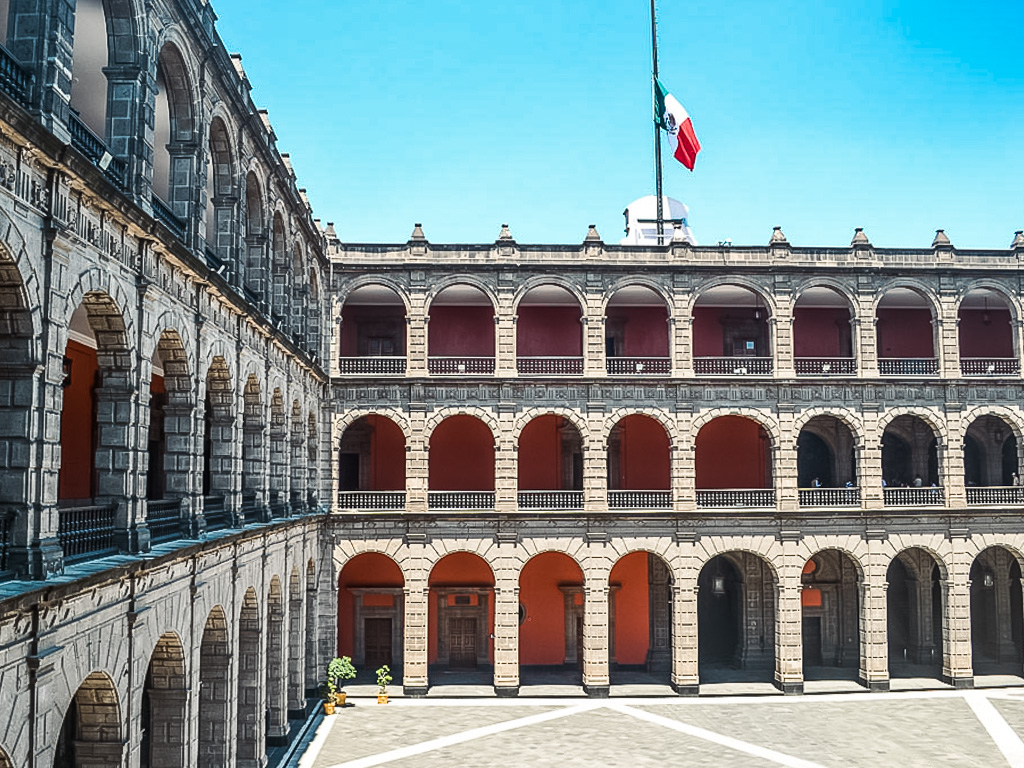
Templo Mayor
By Dan from Latin America Backpacking
When it comes to things to do in Mexico City, one of the attractions you won’t want to miss is Templo Mayor. Located next to the Zocalo this unmissable Museum offers its visitors a unique insight into the Aztec culture. Although the Spaniards destroyed much of the temple, the surviving ruins along with the artifacts on display help to give you more information on what the Mayan world was like.
With object descriptions in both English and Spanish, the thoughtfully curated displays provide you with historical context and insights that go deep not only into the daily life of the Aztecs, but also into elements such as religious beliefs and, political structures. It is from outside you can see the foundations of the temple complex and it is the indoor gallery that shows numerous archaeological pieces from the past, some of which have been displayed in chronological order.
It is worth knowing that you are not allowed to carry food and drink inside, and even bottled water is prohibited, so be sure not to carry any provisions with you to this landmark. Also, if you are visiting on a Sunday it is free to enter. All in all, this magnificent museum is a must if you are spending 2 days in Mexico City or more, as you will need to spend a couple of hours to fully appreciate this landmark.
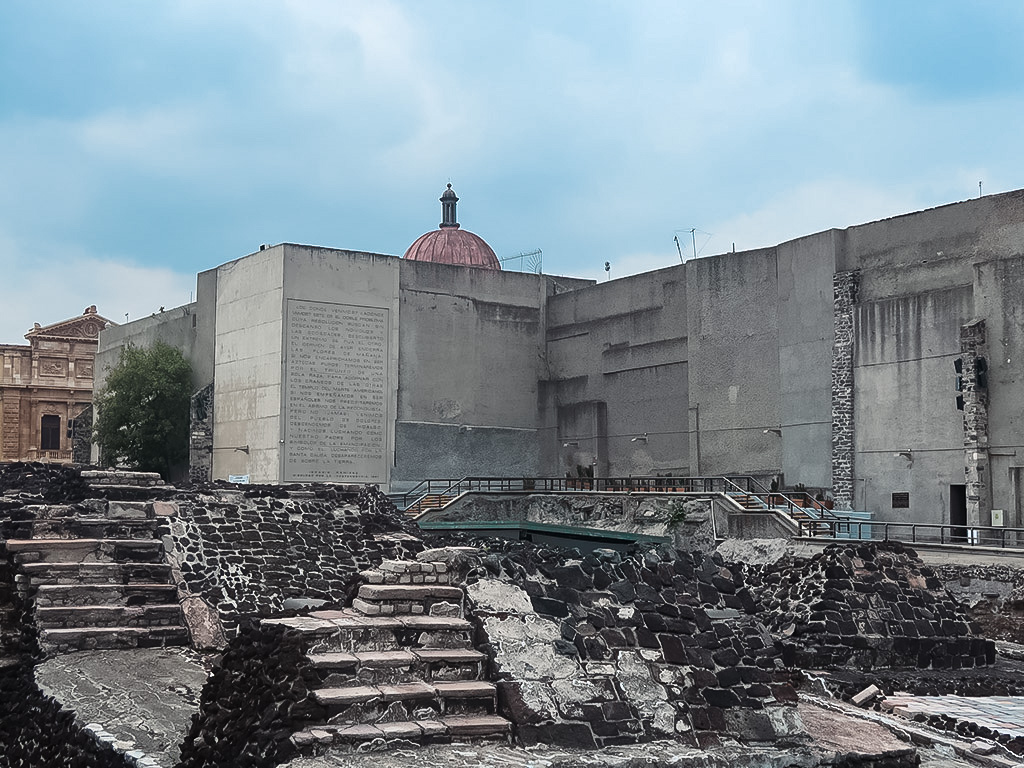
Palacio Bellas Artes
Recommend by Erin of Sol Salute | Instagram: solsalute
The Palacio de Bellas Artes is in the heart of Mexico City’s historic center and is a must see attraction. The exterior is opulent art nouveau but the interior contrasts that with modern art deco.
To tour the interior, it is open every day of the week except on Mondays from 11 am to 5 pm. Guided tours are offered twice a day from Monday to Friday. But it is not necessary in order to enjoy this museum. Entrance is 85 pesos and to take photos costs an extra 30 pesos.You’ll be given a sticker to wear to show that you’ve paid for permission to take photos and it is worth every penny. There is a bag check for leaving larger bags and backpacks.
The second and third floors are the highlight, home to some of the most important Diego Rivera murals in Mexico City as well as murals painted by other important artists, such as José Clemente Orozco, and David Alfaro Siqueiros.
Also within the Palacio de Bellas Artes is the Museo del Arquitectura, dedicated to modern architecture and the importance of maintaining the country’s historic structures. Or for a night you’ll never forget, see a ballet or the symphony here during your stay in Mexico City.
Don’t miss the external views of Bellas Artes. Cross the street to the Sears facing the entrance to the theater. Find the elevator and head to the 8th floor where you can get a coffee at the cafe with the best view of the Palacio de Bellas Artes. Be sure to visit in off peak hours or expect a wait.
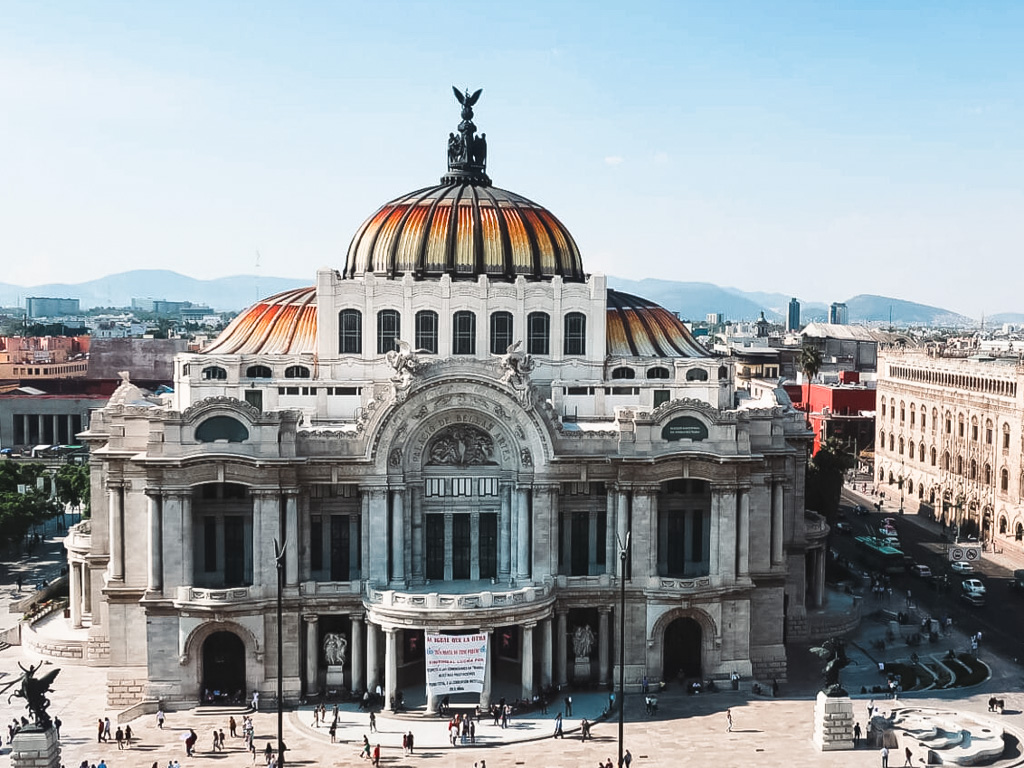
Torre Latinoamerica
One of the tallest buildings in Mexico City, Torre Latinoamercana is located a hop across from Palacio de Bellas Artes. Purchase a ticket to Mirador Torre Latino and head to the observation deck on 44th floor to get unique bird’s eye perspectives of the city.
From the mirador, enjoy 360 degree views of Mexico City’s impressive skyline. Modern skyscrapers and historic buildings from colonial era, lush parks and sprawling urban neighborhoods, it is fascinating to see how every element of the city has been packed in a grid like layout.
Mirador Torre Latino is open from 9:00 am to 10:00 pm. However, we recommend visiting around sunset hour. This will allow you to get both daytime and nighttime views of the city. It is magical to witness the sight as the sun goes down and the twinkling city lights start to appear.
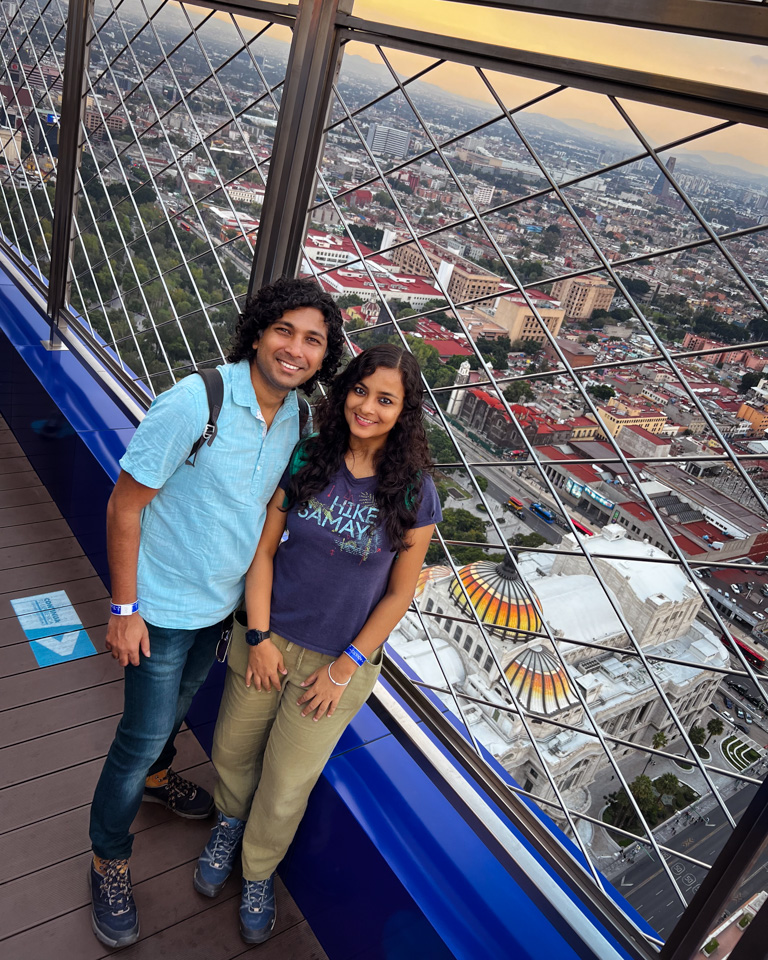
House of Tiles
The House of Tiles, locally known as La Casa de Los Azulejos, is an iconic building, dating back to the 18th century. It draws visitors in with its stunning blue and white tile work that covers the entire facade.
Originally built as a private residence, the House of Tiles has gone through change of ownership many times over the years. Today, it houses a restaurant from one of the most popular Mexican chains, Sanborns. Explore the courtyard, adorned with graceful columns and intricately designed tiles, and take a moment to enjoy a coffee or a bite to eat.
We visited the House of Tiles early in the morning, when the sun is just right for some portrait photos in pleasant lighting, against the backdrop of the stunning blue and white tile walls. Of course, we followed that up with a filling traditional Mexican breakfast at Sanborns.
Palacio Postal
When looking for things to do in Mexico City, you will never fall short of finding an impressive historic building. Such is the architectural grandeur in the city that even a post office makes it to this list!
Palacio Postal, designed by Italian architect Adamo Boari, served as the headquarters for the Mexican Postal Service during the Porfirio Díaz era. We find it interesting that this building, straight out of a page of history, still functions as a regular post office!
With unique architectural features such as marble floors, intricate ironwork, and a beautiful glass ceiling, the interior and the exterior of the building are stunning. You will also find antique stamp vending machines and murals depicting the post office’s operations. A visit to the Palacio Postal offers a perfect blend of history, art, and architecture and is a great photo opportunity for your travel album.
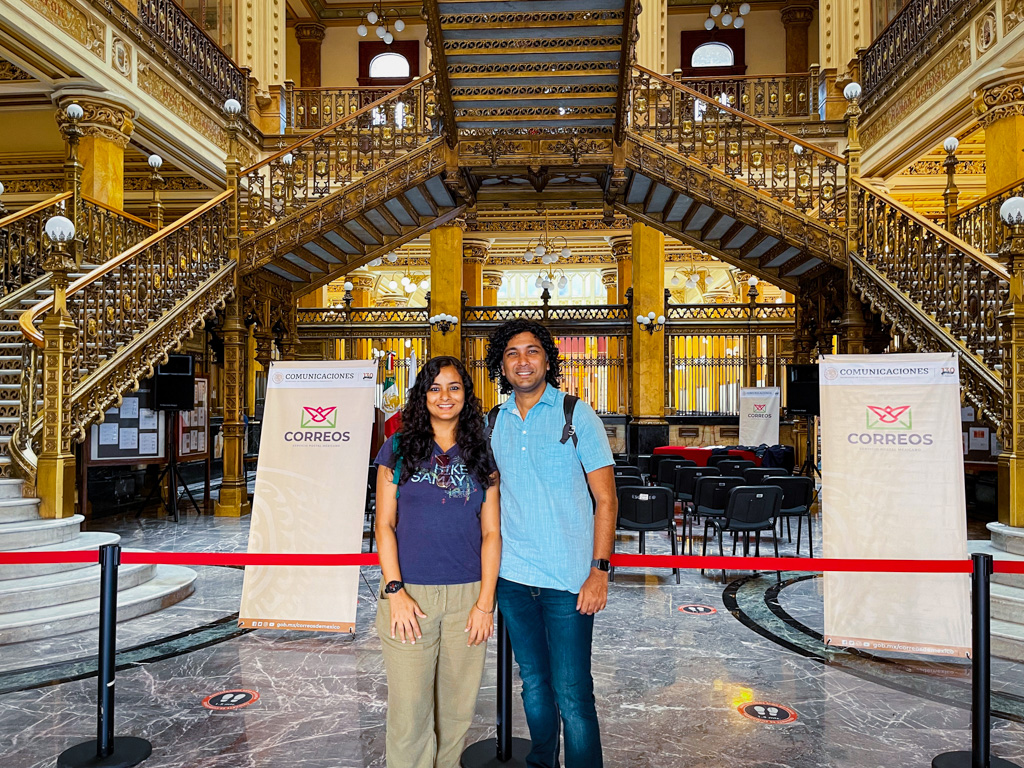
Angel of Independence
The Angel of Independence is a must-see attraction in Mexico City. Located on the bustling Paseo de la Reforma, this iconic monument symbolizes Mexico’s fight for independence.
The golden angel atop the column is striking, and the surrounding sculptures and plaques offer a glimpse into the country’s history. To know more about the monument and the history it represents, you can take a tour that lets you wander around the base of the monument. However, with prior planning, you can also climb to the top on some weekends between 10:00 am and 1:00 pm.
Whichever way you choose to experience the monument, do not forget to snap a photo with the Angel as a souvenir of your time in this incredible city.
2 photos with the Angel: 4 years apart, one from a business trip, the other from the first month of nomadic slow travel.


Monumento a la Revolucion
The Monumento a la Revolución is a triumphal arch that stands tall at 220 feet. It was originally built as a legislative palace before being converted to honor the revolutionaries who fought for Mexico’s independence. This impressive monument, located in Plaza de la República, is a top attraction in Mexico City.
Take the elevator to the top for stunning panoramic views of the city. Inside, you can explore exhibitions that showcase artifacts and historical documents that tell the story of the Mexican Revolution. You can also enjoy the beautifully landscaped gardens surrounding the monument, providing a peaceful break from the busy city.
You can purchase the entry tickets to Monumento a la Revolución on the spot. It costs 150 MXP per person for regular adults, and lower for students and children. However, if you buy tickets online in advance, you may find promotional prices, particularly for group entries. The ticket includes access to foundations, panoramic elevator, observation deck with 360 degree views and viewpoint at the top.
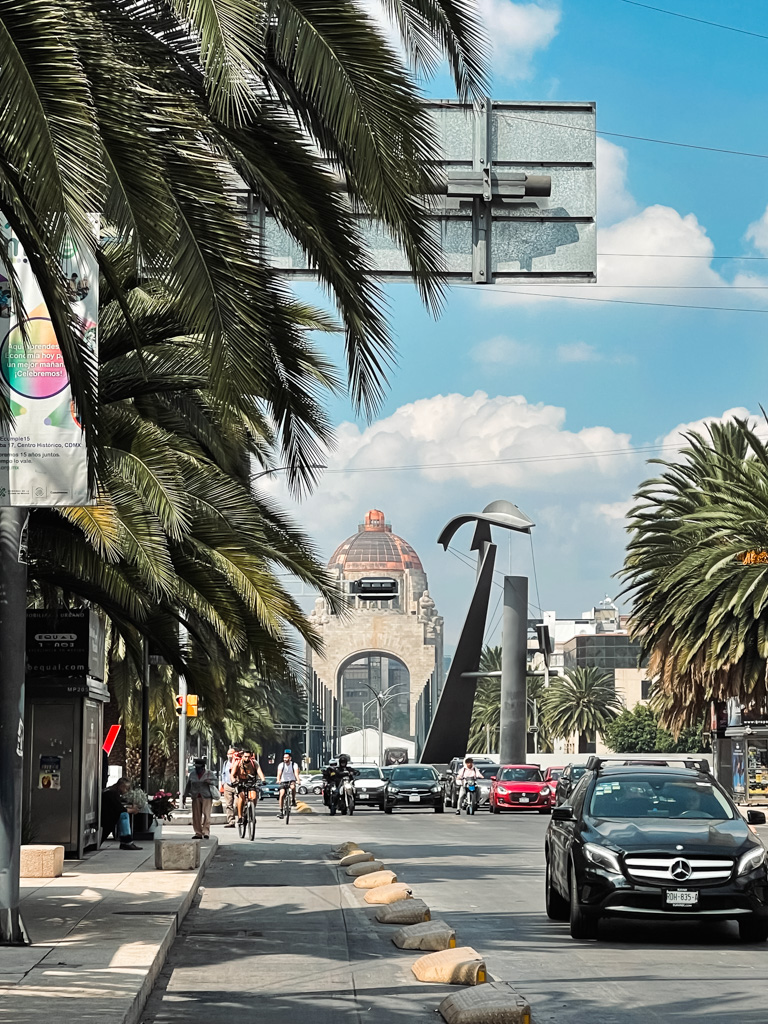
Diego Rivera Mural Museum in the Alameda Central
By Paul Hudson of Playas y Plazas | Instagram: playasyplazas
Diego Rivera is one of Mexico’s most famous artists whose personal life was possibly more notorious than his art. During the first half of the 20th century, he was in the middle of a great deal of important historical events. It is no surprise that the artist had his own interpretation of the history of Mexico and the geopolitical events of the day.
There are many murals by Diego Rivera in Mexico City but Dream of a Sunday Afternoon in the Alameda Central is special. The mural is located in the park that is depicted in the mural. After touring the mural you can walk through the park like Rivera did a hundred years ago. The Alameda Central is part of the history of Mexico City.
The mural was originally located in the Versailles Restaurant of the luxurious Prado Hotel. Rivera’s decision to depict atheist politician Ignacio Ramirez and the words, “God does not exist” ignited massive controversy. Vandalism forced the mural to be partially covered. At one point, the cement fresco was moved from the hotel restaurant to the lobby.
The large mural had to be reinforced with a steel frame to be moved from one floor to another. That steel reinforcement would end up saving the mural from destruction when the 1985 earthquake leveled the Prado Hotel and hundreds of buildings across the region.
Dream of a Sunday Afternoon in the Alameda Central was rescued from the rubble and moved across the street to the Alameda Central where a museum was built around it. Today, it is one of the most popular Diego Rivera murals with dozens of stories about Mexico City.
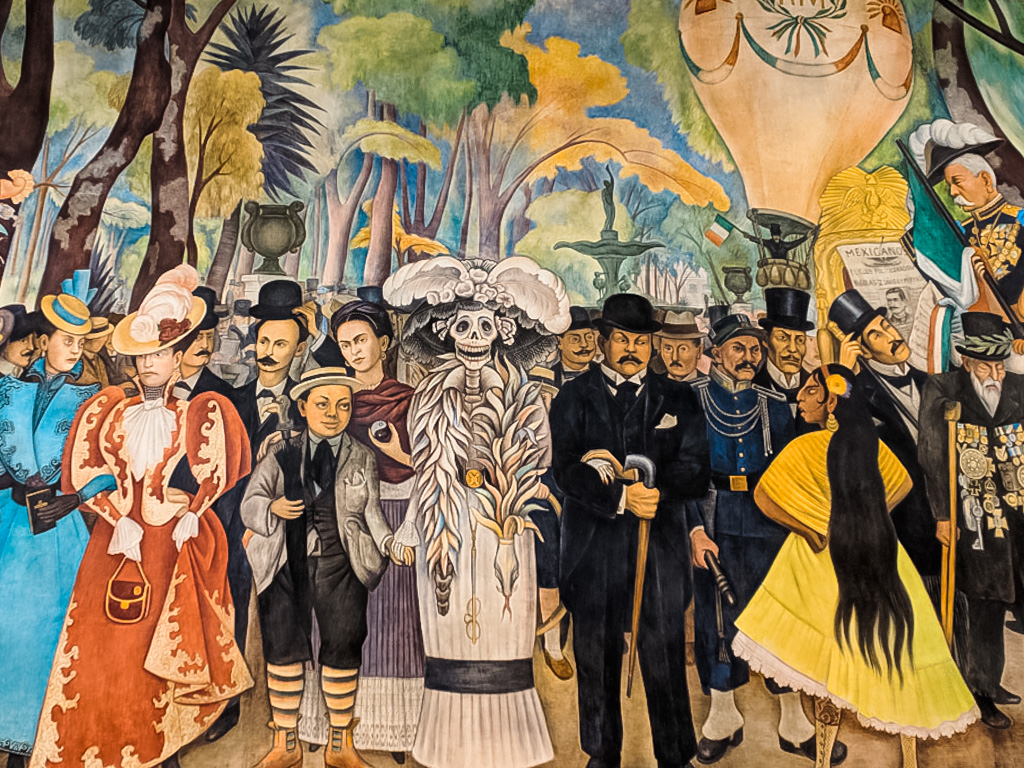
Visit Frida Kahlo Museum
Recommended by Claudia Tavani of My Adventures Across The World
There are many fantastic museums in Mexico City, but if you decide to visit just one during your trip to the Mexican capital, make sure to go to Frida Kahlo Museum.
Known as Casa Azul (Blue House in English), you will find this small museum in the beautifully quaint Coyoacan district, one of the nicest and quietest areas of Mexico City. As its name may give away, the entire museum is dedicated to the life and work of Frida Kahlo, who was born in Mexico City. This is where she lived and produced a lot of her works.
You can browse through the house to check out Frida’s dining room, her garden, her bedroom and various personal belongings that detail her life and work, and her relationship with fellow artist and teacher Diego Rivera.
You will also be able to admire some of her most popular works – namely, Viva La Vida (Long Live Life), Mi Familia (My Family), and Frida Y La Cesarea (Frida and the Cesarean).
Occasionally, the museum holds special exhibits dedicated to local artists or even to other details of the life of Frida, such as her unique style in clothing.
Casa Azul is a popular place to visit. So, plan to buy your tickets online in advance.
Related Reading: A personal account of visiting Frida Kahlo Museum
Leon Trotsky Museum
Located in the tranquil neighborhood of Coyoacán, this museum offers a fascinating glimpse into the life of one of history’s most influential political figures, Leon Trotsky. The Leon Trotsky Museum is housed in the actual home where Trotsky lived during his exile in Mexico.
As you step inside, you will find yourself immersed in his world, surrounded by personal belongings, photographs, and even the study where he spent countless hours writing. Take a guided tour to learn about Trotsky’s revolutionary ideas and his tumultuous time in Mexico. The knowledgeable guides will share captivating stories and anecdotes, giving you a deeper understanding of Trotsky’s impact on history.
The museum also includes the serene garden where Trotsky and his wife, Natalia Sedova, used to relax. It is a peaceful spot to take a moment of contemplation and reflect on the legacy of this remarkable figure. Visiting the Leon Trotsky Museum is not only a chance to learn about Trotsky’s life and ideology, but also an opportunity to explore the history of Mexico in the early 20th century.
Museo Soumaya
By Imee Magbag from Journey To Mexico
Established in 1994, Museo Soumaya, often referred to as the Soumaya Museum, is a renowned art museum in Mexico City, Mexico.
It is recognized for its impressive architecture, and the museum’s unique building stands out prominently with its shiny silver exterior. The building is an architectural masterpiece designed by the acclaimed Mexican architect Fernando Romero.
One of the most remarkable aspects of Museo Soumaya is its extensive art collection. The museum holds diverse artworks, including paintings, sculptures, artifacts, and historical objects from various periods and cultures. Visitors can explore a comprehensive selection of European art, including pieces by renowned artists such as Auguste Rodin, Salvador Dalí, Vincent van Gogh, and Pablo Picasso.
Aside from the European collection, the museum also showcases some Mexican historical art created by prominent Mexican artists like Diego Rivera and Rufino Tamayo.
The museum offers free admission to the public and hosts various educational programs, workshops, making art accessible to all ages. Museo Soumaya has become an iconic museum and a symbol of Mexico’s commitment to the arts.
With its dedication to preserving and promoting art, The museum attracts art enthusiasts, tourists, and locals alike, and it also remains a must-visit destination for art lovers from around the world.
Visiting Mexico in March can be a great time to explore Mexico City and its historical sites and museums. Exploring these sites and the prominent museums like Museo Soumaya, during spring break allows you to enjoy the pleasant weather while delving into Mexico’s fascinating history.
Museo Nacional de Arte (MUNAL)
When exploring Mexico City, add another important one to your list of museums to visit. Museo Nacional de Arte (MUNAL) is an incredible museum that is home to an extensive collection of Mexican art spanning from the colonial period to modern times.
As you step inside MUNAL, you will be greeted by a stunning display of paintings, sculptures, and other art forms. From the works of renowned artists like Diego Rivera and Frida Kahlo to lesser-known gems, the museum offers a comprehensive overview of Mexican art history.
Take your time to wander through the various galleries, each showcasing a different era or style. You will be captivated by the vibrant colors, intricate details, and thought-provoking themes that artists have captured over the centuries.
Do not miss the chance to explore the museum’s temporary exhibitions, which often feature contemporary artists pushing the boundaries of Mexican art. There is always something new and exciting to discover at MUNAL.
The museum is not only a visual delight but also an educational and cultural experience. It presents the perfect opportunity to immerse yourself in the rich artistic heritage of Mexico and gain a deeper appreciation for its diverse and vibrant art scene.
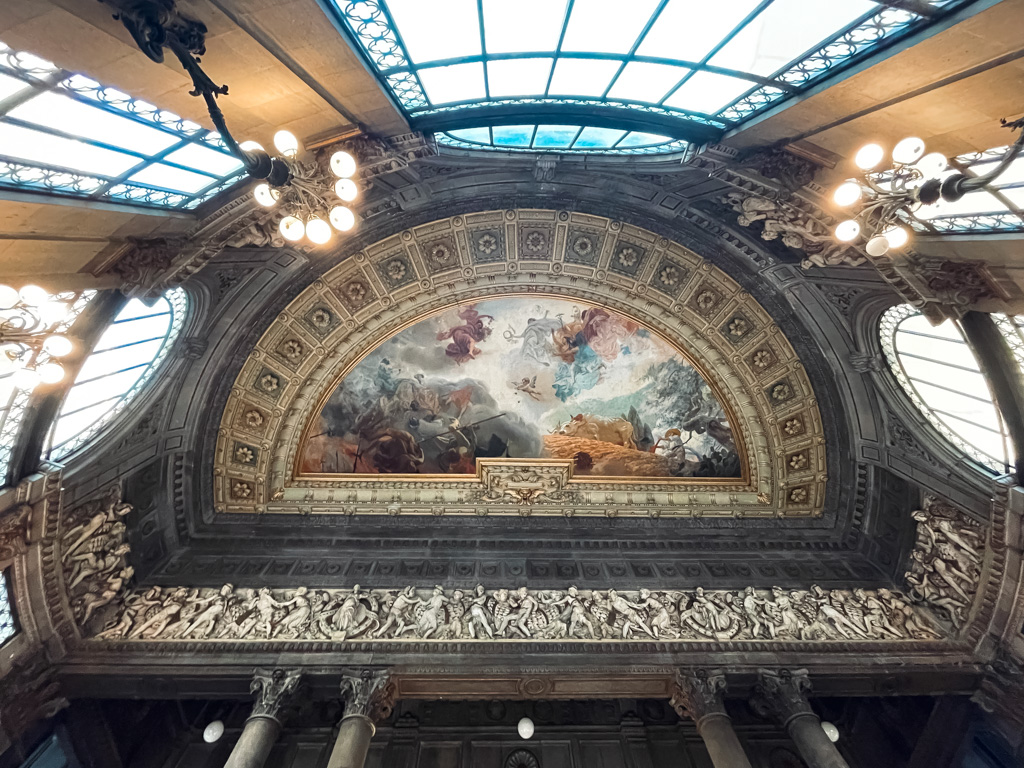
Luis Barragán House and Studio
By Ossama from Awesome Traveler
Luis Barragán House and Studio is one of the best places to visit in Mexico. Built in 1948, the studio is a UNESCO World Heritage Site that people from all over the world flock to it to experience what it has to offer. It is the home of the famous engineer and architect Luis Barragán who created some important landmarks in Mexico, such as gardens, houses, fountains and plazas. He won the Pritzker Price in 1980.
He created a new method that he called the “emotional architecture,” and started to apply it in New Mexico. His method of architecture encourages meditation and quietude. The majority of his works are in Guadalajara and Mexico City. A good example of his work are Casa Barragan, Torres De Setelite, Casa Gilardi, and Cuadra San Cristobal. All architecture mentioned above are in New Mexico, so you can definitely pay them a visit.
Luis Barragán House and Studio is make of concrete and stand tall at about 1,161 m2. It consists of a first floor, two upper stories, and a private garden. The house integrate between modern and traditional arts, which makes it one of the top things to do in New Mexico. It was designed and lived in by Luis until he passed away in 1948. Nowadays, it is an open museum that dedicated to his work.
His usage of interior colors fascinate the visitors in many ways. You are not only welcomed by a gorgeous small garden, but also with kaleidoscope of bright colors, fountains, and pools. It is uniquely designed that also blind with the neighborhood and streets. You need to book a tour that cost $400 Mexican dollars, which is $20 US dollars.
Anthropology Museum
Recommended by Catherine of Nomadicated | Instagram: nomadicated
The National Museum of Anthropology in Mexico City stands out for its impressive collection of artifacts and exhibits showcasing pre-Columbian civilizations, including the Maya, Aztec, and Olmec cultures. The organization of the museum helps visitors understand the context and timeline of Mexican history.
To plan your visit, take Mexico City’s public transportation to Metro Auditorio (Line 7) or Metro Chapultepec (Line 1), then walk the remaining 1.3 kilometers. Note that the museum is open Tuesday to Sunday from 9 am to 5 pm and is closed on Mondays. Ticket prices can be bought online or in person for 90 Pesos and are free for nationals and residents on Sundays. Guided tours are available for an additional fee.
Once there, explore the museum’s extensive collection of 23 permanent exhibit halls. Some of the highlights include:
- The Aztec Hall: features the famous Aztec Calendar Stone and a replica of the Templo Mayor.
- The Maya Hall: displays artifacts from the ancient Mayan civilization, including Pakal’s tomb.
- The Oaxaca Hall: the jade mask of the Zapotec Bat God and culture of the Zapotec and Mixtec people of Oaxaca.
- The Teotihuacan Hall: displays artifacts and models of the impressive pyramids and structures of the ancient city of Teotihuacan.
After visiting the museum, stroll through nearby Chapultepec Park, one of the largest urban parks in the world. There, you’ll find several other museums and attractions, including the Chapultepec Castle, with great views of the city.
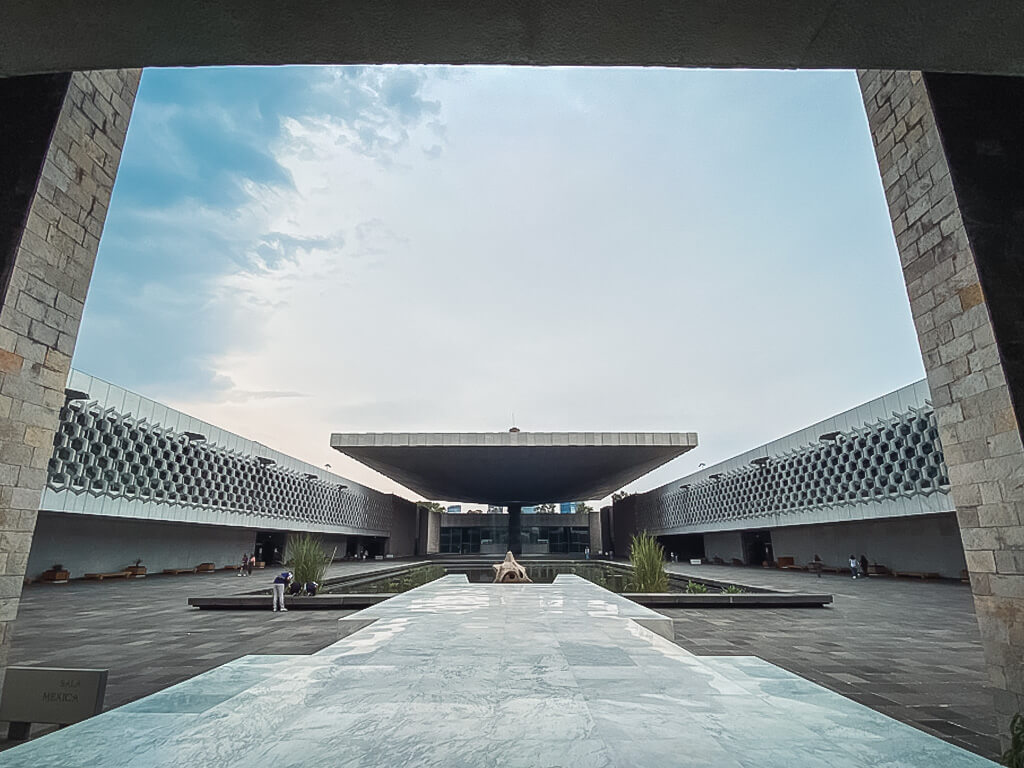
Chapultepec Park
By Noel Morata of Travel Photo Discovery | Pinterest: nmorata
Chapultpec Park located in the center of Mexico City is huge and filled with everything from castles, world class museums, a huge zoo, two large man-made lagoons, restaurants and even a weekly market to enjoy. This historic park is even larger than New York City’s Central Park and is the greenbelt of the entire city where locals and tourists enjoy the wide open spaces and outdoor activities around the park area.
You can get some fantastic views from above at Chapultepec castle, where the Mexican rulers and presidents ruled the country along with the wonderful historic museum next door that you can easily visit as part of the ticket price. Strolling around the many outdoor areas, the botanical garden and various greenbelt areas of Chapultepec can easily take up an entire day especially if you love museums and there are plenty to visit within the park.
The park is also accessible by Metro and you can directly exit at the Chapultepec park entrance and just walk around, or if you prefer, you check out the biki bike rentals at the park to cover more ground exploring and doing some exercise at the same time.
You can opt for doing a lot of exploring around the park or just pick a tranquil spot along the lake waterfront and try any of the local snacks sold by vendors nearby. It’s a nice mix of just enjoying being outdoors and checking out all the attractions you will find available here.
Chapultepec Castle
When exploring the Chapultepec area, set aside a good amount of time for visiting the Chapultepec Castle. The castle was originally built in the 18th century for the Spanish viceroys. But over the period of time, it has served as a military academy, an observatory, as well as the presidential residence. In 1939, it was opened to the public as the National Museum of History.
The ornate architecture, intricate details, and stunning artwork of Chapultepec Castle are a testament to Mexico’s rich cultural heritage. You will be transported back in time as you walk past the rooms and exhibits here. For a refreshing mix of history and modernity, take a look on the other side from the terrace, You will get breathtaking views of modern Mexico City skyline pierced by high rises peeking through the canopy of the Chapultepec forest.
The museum is open all year round, Tuesdays through Sundays, between 9:00 am and 5:00 pm. You can buy the ticket directly at the ticket booth on the day of visit. But remember to purchase the ticket before starting the uphill hike to the castle. Else you will need to come back and do the uphill walk again!
A little trivia for movie buffs – this beautiful castle in Mexico City was one of the filming locations for the Leonardo DiCaprio starrer Hollywood movie Romeo and Juliet!
Best Tacos in Mexico City
Recommended by Sara of Travel Mexico Guide
Mexico City is the place to be for some of the best tacos in Mexico. From street food stands to famous taquerias, there’s something for everyone.
Whether you’re a fan of traditional Mexican cuisine or looking to try something new, you won’t be disappointed by what this vibrant city has to offer. And if you’ve watched Netflix’s popular show Taco Chronicles, you’ll recognize many of its famous taquerias here in Mexico City.
As someone who loves tacos al pastor, I was especially excited when I heard about all the amazing taco places in Mexico City. Taqueria Orinoco offers up northern Mexican style tacos with unique toppings like nopales cactus strips and queso fresco cheese, while Taqueria los Gueros de Boturini serves up authentic tacos al pastor from their trompo (vertical spit).
For those looking for suadero tacos – one of my favorites – look no further than Taqueria los Cocuyos where they make some of the best suadero tacos around town.
But if it’s tradition that you seek then La Jalisciense is the place to go. This historic taqueria is said to be the oldest taco shop in Mexico and has been around since 1875, so it’s no wonder why they use old-school methods like baking their fresh tortillas in wood fire ovens and grilling meats on a charcoal pit.
So whether you are a fan of classic types of tacos in Mexico or looking for something new, Mexico City is your go-to!
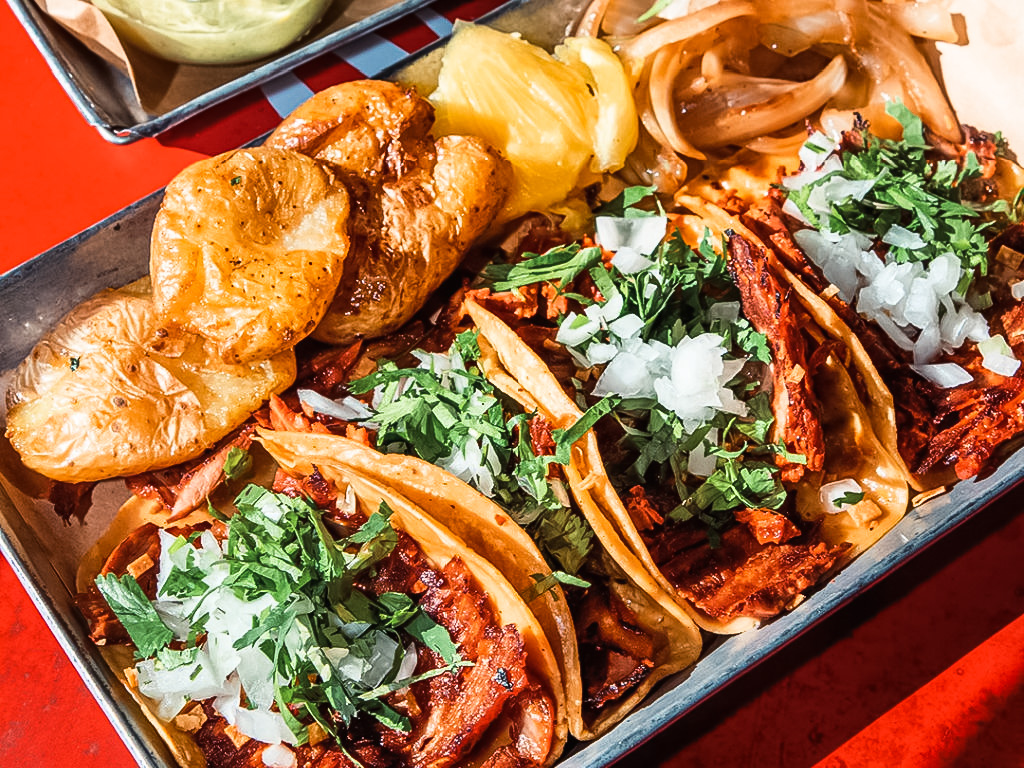
Colonia Roma Food Tour
Recommended: by Daniel of Dan Flying Solo | Instagram: danflyingsolo
It might seem totally unnecessary to take a food tour in Mexico City when you can taste first-class tacos, tamales and tortas on every street corner, but to genuinely get a deeper bite of CDMX, book yourself in with a guide to savour the flavours and the facts.
One of the most exciting neighbourhoods to do this in is Colonia Roma, where the long-standing team at Sabores Food Tours run in-depth tours, bringing the city’s (and the country’s) culture to life through cuisine.
Over four hours, you’ll be guided on a journey of unexpected recipes, from all-vegan tacos constructed from coconut, breadfruit and beets in La Pitahaya Vegana and the Fava Bean Soup that’s typical of the city to more up-scale restaurants where creative chefs are doing magic with Nopales (cactus) — each morsel is more intriguing than the last.
However, the reason this neighbourhood is one of the best to take a food tour in is the constant change. Home to some of the capital’s grandest European-style architecture, which backs street food stalls and streets damaged by earthquakes, it’s a contradicting quarter of the city that’s constantly seeing new restaurants come and go, ensuring kitchens really have to stay on top of their game.
Of course, you don’t need a guide to explore one of CDMX’s safest and trendiest neighborhoods when excellent eats are all around. But, to really find those tucked-away tamale joints, and know what’s truly up-and-coming rather than just tourist-primed, book a tour with the experts – your tastebuds will thank you.
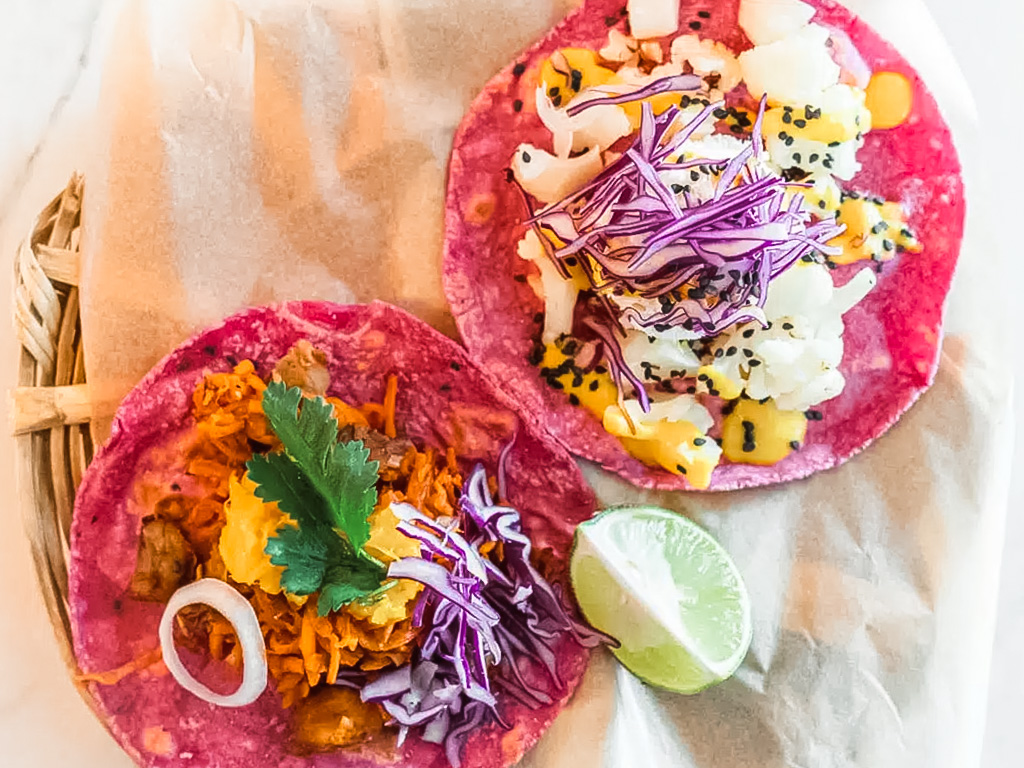
Sample the Best Street Food – without a tour
By Victoria from Guide Your Travel / IG: guideyourtravel_
Embarking on a street food adventure in Mexico City is an absolute must for any food lover. As a traveller who has personally experienced the vibrant culinary scene of this bustling metropolis, I can attest that indulging in the best street food is one of the most memorable and enjoyable things to do in Mexico City.
Activity: Exploring the Street Food Markets
Make your way to renowned street food markets such as Mercado de la Merced, Mercado Roma, or Mercado San Juan. These bustling markets are a sensory delight, offering an array of tantalizing aromas and mouthwatering dishes that showcase the rich flavours of Mexican cuisine. The options are endless, from tacos al pastor and tamales to Churros and Elotes (grilled corn on the cob). Engage with local vendors, learn about their culinary traditions, and savour the diverse regional specialities.
Why It is One of the Best Things to Do
Mexico City’s street food scene is a vibrant reflection of the country’s rich culinary heritage. Sampling the street food allows you to immerse yourself in the local culture, taste authentic flavours, and experience the city’s gastronomic diversity. From street carts to bustling markets, you’ll find a vast array of affordable and delectable dishes that will leave you craving more. The freshness of ingredients, the boldness of spices, and the passion of the vendors create an unforgettable culinary adventure.
Planning Your Visit
To make the most of your street food experience, consider visiting the markets during the daytime when they are in full swing. Start with smaller portions to allow yourself to try a variety of dishes. If you’re unsure about hygiene, look for stalls with long lines or seek recommendations from locals. Remember that street food can be spicy, so be prepared for some heat. It’s also advisable to carry cash as many street food vendors may not accept cards.
Dine at Pujol Restaurant
Moving beyond the street food scene, if you are looking for a fine culinary experience in Mexico City, then Pujol is a must-visit. This restaurant, led by Chef Enrique Olvera, has been named one of the best restaurants in the world and for good reasons.
The menu is a work of art, featuring traditional Mexican ingredients with a modern twist. You can choose between a classic tasting menu and chef’s special everyday changing menu. The presentation of each dish is beautiful. The atmosphere of the restaurant is also noteworthy, with a sleek and modern design that feels both elegant and comfortable.
Due to its popularity, the restaurant does fill up fast, so we recommend you to make your reservation well in advance. Make a reservation online on their website or call them up on +52 5555454111.
Given the affordable price ranges for food in Mexico City, Pujol is definitely on the higher end of the spectrum, but the experience is truly one-of-a-kind. If you are looking to splurge on a special occasion or just want to treat yourself to a culinary adventure, Pujol is worth the price tag.
Huerto Roma Verde: Roma’s Vibrant Community Garden
Recommended by Annie of Your Friend the Nomad | Instagram: annieelenaphoto
Mexico City is not known as an ecotourism destination. But in the chaos of the city, you’ll find a unique space created by local activists and environmentalists. It’s called Huerto Roma Verde and is located in the heart of Mexico City’s Roma neighborhood.
Huerto Roma Verde could be described as a community garden, but the organization’s large vision for community transformation and resilience makes it feels like so much more than that. The vibrant space was created in 2012 in a lot that had been abandoned for several decades after two buildings collapsed in a 1986 earthquake.
Today the space features gardens rooted in indigenous permaculture, sustainable housing models created from recycled materials, and a diversity of other innovative initiatives.
Nearly every weekend, Huerto Roma Verde hosts lively events—from farmer’s market-style bazaar days with abundant local art to their annual vegan festival each spring. Throughout the week, the space hosts workshops, classes, and a coffee shop. Visitors are warmly welcomed to Huerto Roma Verde’s events, though most attendees are local to Mexico City. This makes a stop by Huerto Roma Verde a unique and local experience during any Mexico City trip.
To find out if Huerto Roma Verde is hosting any events of interest during your trip, check their website beforehand, or walk by the space. Even if there are no events happening, its worth checking out the area. The garden is sometimes open to visitors, and there are always several vendors just outside the garden.
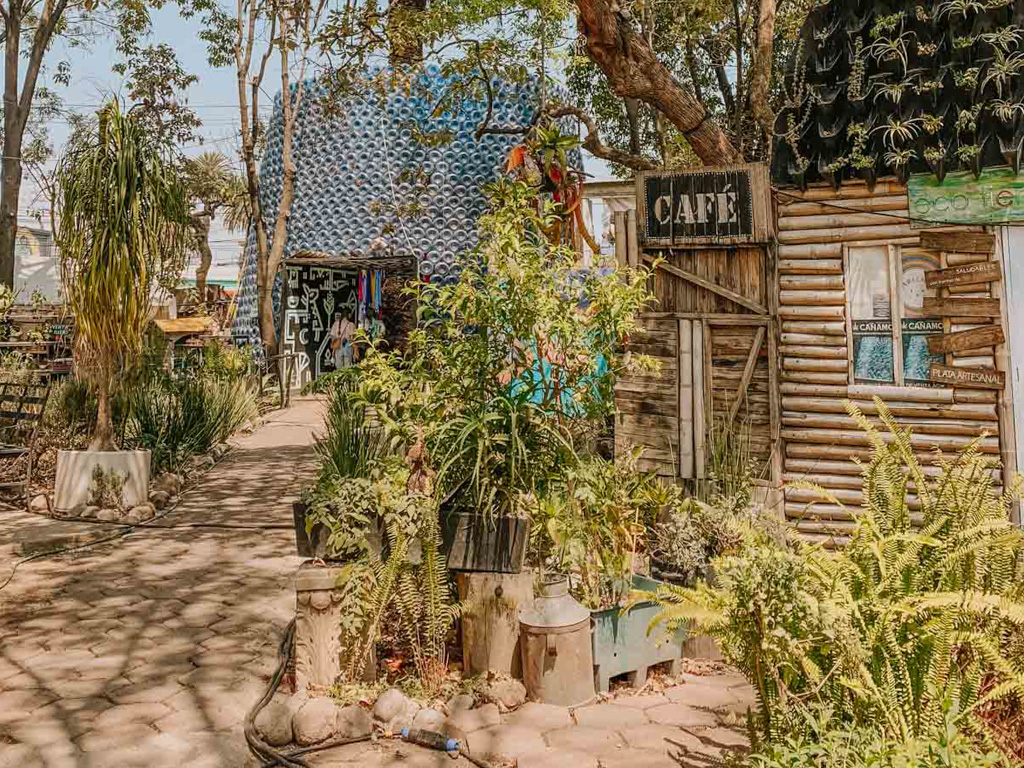
Lucha Libre Wrestling
By Ashlea J. Russell from She Roams About | Instagram: sheroamsabout
It’s hard to find a more Mexican activity than watching Lucha Libre in Mexico City. The second most popular sport in Mexico after soccer (futbol), Mexican wrestling is a national phenomenon that calls Mexico City home.
Most Lucha Libre matches in Mexico City take place at Arena Mexico on Tuesday and Friday nights. Tickets are inexpensive and can be purchased in advance, with a tour, or on the day at the box office.
When you enter the arena the atmosphere is electric. Flying masked Luchadores (wrestlers), fire cannons, strobe lights, music, and a very vocal crowd make for an exciting experience unlike anything else. You don’t need to be a wrestling fan to enjoy this spectacle.
A blend of theatre and athletics, Lucha Libre is a wildly entertaining retelling of the age-old battle of good vs evil. The good guys, known as Tecnicos, are the crowd favourites. They follow the rules and perform advanced and impressive moves. The bad guys, known as the Rudos, are there to win by any means necessary. They are sneaky, and unpredictable, sometimes taking the match out of the ring and onto the floor.
It won’t be long before you’re following the lead of the crowd, booing and cheering along like a local. Outside the arena after the match you can try some street food, shop for your own Luchador mask, or make your way to a nearby cantina for live music to round out the night.
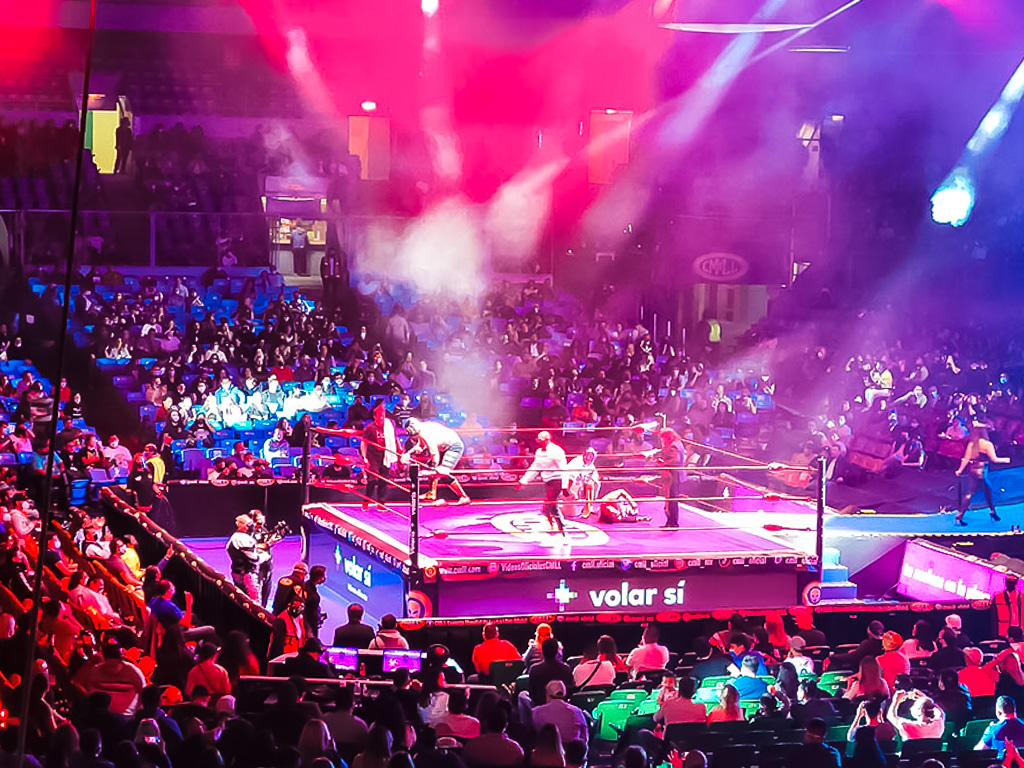
Azteca Stadium
Recommended by Odo of Caribe Vibes
I recently had the opportunity to visit Estadio Azteca in Mexico City, and it was indeed an unforgettable experience. As a huge soccer fan, I was thrilled to step foot in the stadium that has hosted two World Cup finals and is home to one of Mexico’s most famous soccer teams, Club America.
As I approached the stadium, I was struck by the impressive façade adorned with murals depicting some of the most memorable moments in Mexican soccer history. Stepping inside the stadium, I was immediately swept up in the energy of the passionate Club America fans. With a seating capacity of over 87,000, the stadium was buzzing with excitement and anticipation.
Azteca Stadium Tour
Azteca. The stadium offers guided tours that take you behind the scenes and give you a glimpse into the history and culture of Mexican soccer. I took one of these tours, saw the locker rooms and press rooms, and even walked out onto the field.
Booking a tour of the Azteca Stadium is a straightforward process. The easiest way to secure the visit is on Viator, which offers a 90-minute guided stadium tour. The tour includes visiting the locker rooms, the press room, and the field itself, where you can stand in awe of the stadium’s massive size and imagine the crowd’s roar during a game. You can choose your tour’s date and time and pay directly online. With Viator, you can book your tour in advance, and rest assured that you will have a spot reserved for you on the day of your visit.
Even if you are not a soccer fan, I highly recommend visiting the Azteca.
In conclusion, my visit to Estadio Azteca was one of my best experiences in Mexico City. Whether you are a soccer fan or not, the stadium is an iconic landmark steeped in history and culture. Plan your visit during soccer season to catch a game or take a guided tour to learn more about this incredible stadium. Either way, you are sure to have an unforgettable experience.
Cuicuilco Archaeological Site
by Cassie of MexicoCassie | Facebook: mexicocassie
If you tell people you’ve been to Cuicuilco you’re likely to be met with blank looks despite it being a fairly imposing archaeological site in CDMX. This of course also means that when you visit there are unlikely to be hoards of people there. It’s a perfect place to visit with children as there is plenty of space for them to run free here.
Cuicuilco is located in the southeast of Mexico City, near UNAM (University City). It is a ruin far older than any Aztec ruins and very little is known or understood about this site or the people who lived here. It is thought that this population could have been one of the strongest and most important of its time, on a par with the Olmecs in Veracruz and Tabasco.
What is known is that the site was buried when Xitle Volcano erupted around 2000 years ago and that the inhabitants probably moved into Teotihuacan where their culture seems to have been entirely subsumed by the dominant Aztec culture. Archaeologists think that one of the pyramids here was strategically located, demonstrating that this society saw a clear link between their religion and the skies.
The walk to the pyramid is through a peaceful nature reserve and the views from the top of the pyramid of Mexico City are worth the walk even if you’re not super excited by Mexican history. If you are interested, there’s a small museum on site that is worthy of your time. Entry to this archaeological site is free and there is a car park on-site.
The site is open Tuesday to Sunday, 9:00 am to 5:00 pm. Here is the Google Maps location of the site.
Xochimilco
By Claire Sturzaker of Tales of a Backpacker | Facebook: talesofabackpacker
Xochimilco is a unique experience and a must-do in Mexico City. This part of Mexico City is filled with canals and has been likened to Venice, with colourful boats called Trajineras transporting tourists and locals through the canals.
On local holidays and weekends it gets very busy, which can add to the fun atmosphere, with boats jostling for space on the water. The Trajineras are quite large and can hold up to 20 people, so it’s best to visit in a group if you can or prepare to pay more for your own boat.
Bring your own snacks and drinks, or buy from the vendors who have their own boats and will row over if you signal them. Mariachi bands will also come by and you can pay for a performance as they float alongside.
Most of the boat trips will pass by the Island of the Dolls, a creepy display of dolls said to have been put there to appease the spirit of a drowned girl, and a visit to one of the many garden centres on the river banks, but the main attraction is the boats themselves.
Simply being on a boat with a group of friends and a plentiful supply of food, drink and entertainment is a fabulous way to spend an afternoon!
There are tours to Xochimilco available from the centre of Mexico City which usually include a visit to Coyoacan and Frida Kahlo’s House, or you can take an Uber which takes about an hour (or more in heavy traffic). Public transport would take around 2 hours to get to Xochimilco.
Xochimilco Tour Recommendations:
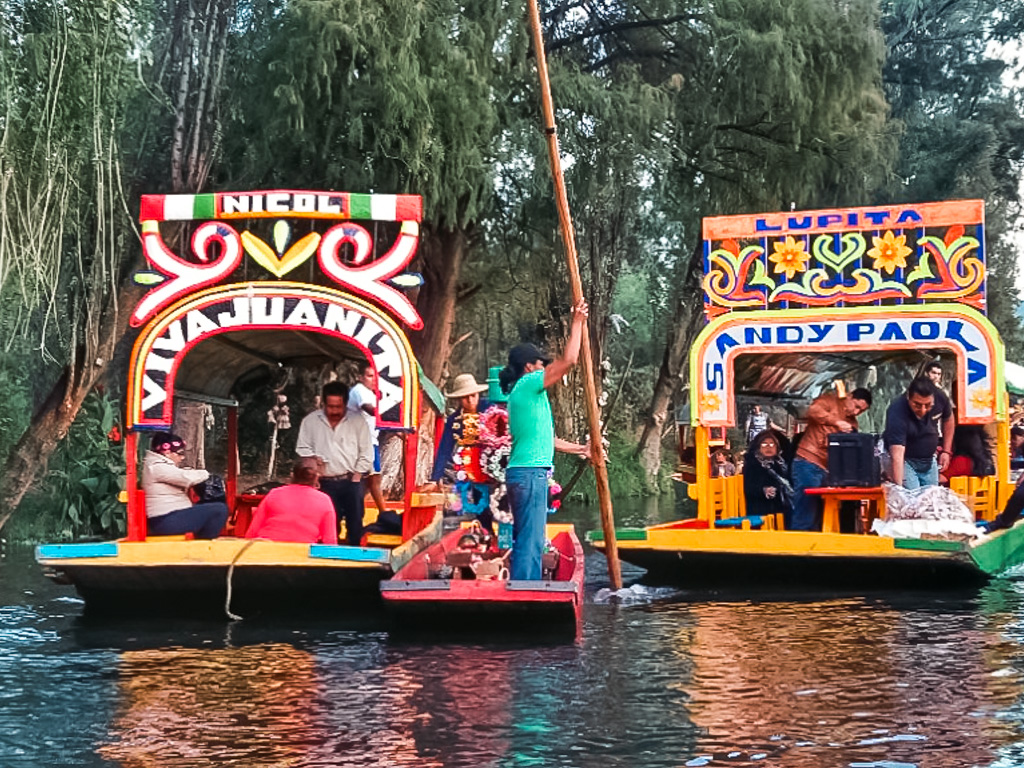
Biking in Mexico City
By Faith from 3 Tickets Please
While Mexico City may not seem bike friendly, the city’s extensive bike lanes, city bike share program and excellent bike tours make it a great city to explore by bike.
Starting your time in Mexico City with a bike tour, versus a walking tour, is an excellent way to cover more ground and get oriented to this large city. You can take a highlights tour that introduces you to several of the important sights and trendy neighborhoods in the city. Or if you are a foodie, you can hop on bikes with a local to discover all the best eats in the city.
We opted to take a specific bike tour that allowed us to explore the beautiful historic neighborhood of Coyocan and afterwards, skip the line at Frida Kahlo’s Blue House. While we could have made our own way to Kahlo’s historic home, the bike tour leading up to the visit was our favorite part, as we felt immersed in the artistic neighborhood that was once Kahlo’s home.
If tours aren’t your thing, you can rent bikes through Ecobici, Mexico City’s public bike share. The neighborhoods of Condessa and Roma are wonderful for biking. However, nothing beats bike ride through Chapultepec Park. The park is twice the size of New York City’s Central Park as is truly the green lung of the city.
Regardless of how you choose to peddle the city, Mexico City is not only accessible by bike, it is one of the best ways to see this vibrant city.
Mexico City Haunted Walk
By Kristin of Tiny Footsteps Travel
Mexico City, being the oldest capital city in the Americas, has a rich history that can be explored in a unique and exciting way through a haunted walk. Having been founded in 1324, there are ruins in the city that date back to the Medieval times, and there is evidence that people have inhabited the area since long before that. Thousands of years of history means the stories of executions, crimes and mysteries and accounts of paranormal activity are extensive and bone-chilling, and give us insight into the cultural and historic roots of the city that we wouldn’t have otherwise.
A haunted walk allows you to uncover darker sides of Mexico City, be spooked, and get your steps in as you see the city by night. Travel with a small group, which allows for an intimate, interactive experience that allows you to get to know Mexico City in a new light.
Haunted walks in Mexico City are offered by a few different providers, many of them locals who speak excellent English and are knowledgeable experts in the history of paranormal activity and Mexico’s sinister past.
You can find an excellent tour offered on AirBnb experiences or Tours By Locals. These tours support small businesses, and give you a chance to learn about Mexico City from a local, and hear about real-life accounts. The stories you’ll hear make for a great discussion piece with your travel buddy, or an entertaining way to get to know the city if you are traveling solo.
Cholula Pyramids Day Trip
Recommended by Haley from Fernweh Foreigner | Instagram: fernwehforeigner
While Mexico City has plenty of great activities and things to see within the city itself, one of our favorite places to visit on a day trip from Mexico City is to the Great Pyramid of Cholula. Located just outside of Puebla, Mexico, the pyramid is about two hours from the center of Mexico City.
The 2,000 year old pyramid is thought to be the largest pyramid in the world that remained hidden under a hill until the late 1800s. What makes this pyramid so interesting to visit is that you can actually walk inside of the pyramid. Note that, it may not be great for those with claustrophobia. On clear days, you can see the Popocatépetl volcano in the background behind the pyramid.
The town of Puebla and the Great Pyramid of Cholula definitely deserve a visit, and it is a super easy day trip to make from Mexico City. There are plenty of tours that run from Mexico City to Cholula but it is also really easy to visit on your own so you can have more time to explore.
When we visited, we were staying in a hotel at the airport and easily took a bus from the terminal straight to Puebla. There are also other bus terminals around CDMX. From the Puebla terminal we took an Uber and went straight to the tunnel entrance. Do not forget to walk up to the top of the pyramid where the church sits. Try visiting earlier in the morning for a better chance of a clear volcano view.
Cholula and Puebla Tour Recommendations:
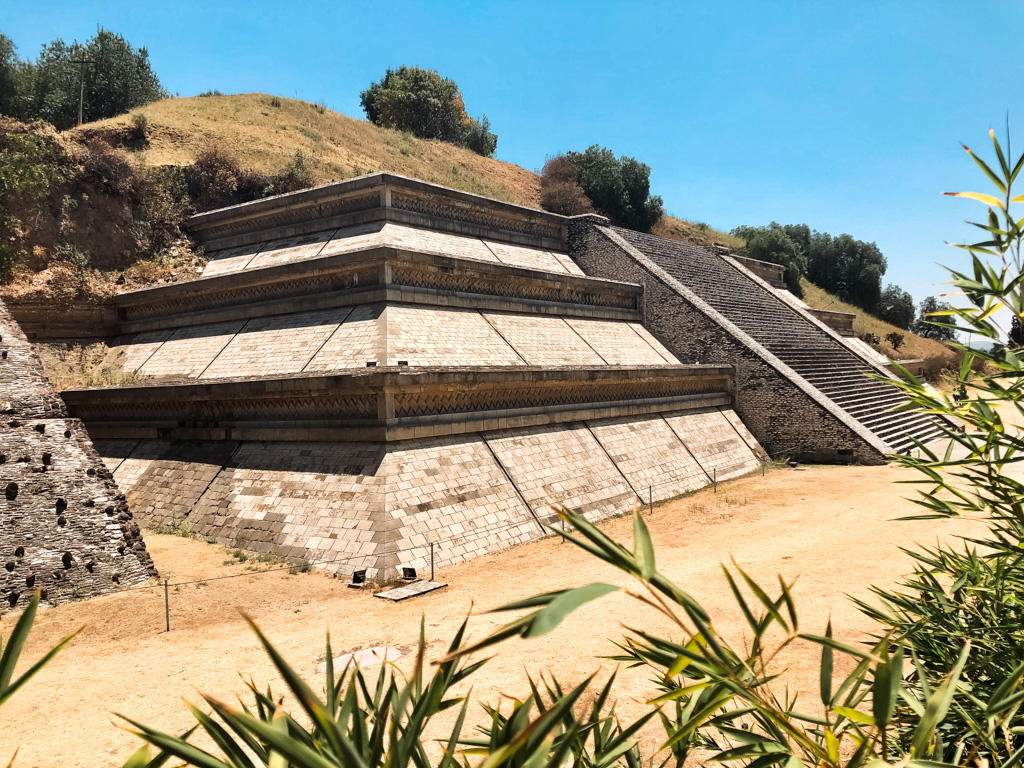
Teotihuacan Ruins Day Trip
Recommended by Anna and Anne of Perspektivan.de | Instagram: perspektivan.de
Visiting the Teotihuacan pyramids near Mexico City is an experience that is worth a day trip. Teotihuacan, which means “the place where the gods were created,” is a UNESCO World Heritage site. It is the most important and largest city of pre-Aztec central Mexico.
Teotihuacan is about 50 km northeast of Mexico City. You can reach the site by private taxi, rental car, a guided tour, or autobus from the Zocalo or Autobus del Norte bus station.
If you plan on driving a rental car in Mexico, it is generally safe to drive a car in Mexico. But it is important to keep a couple of rules of thumb in mind. Especially in the state of Mexico as there are special driving rules because of the air pollution.
Make sure to arrive early in the morning. Hot air balloons rise into the sunrise and the morning mist creates a mysterious atmosphere.
The major attractions are the Pyramid of the Sun and the Pyramid of the Moon. In addition to the pyramids, the site also features several other captivating structures, such as the Temple of the Feathered Serpent. Watch out for the detailed carvings and sculptures.
One of the best ways to experience Teotihuacan is by taking a guided tour, which can provide a deeper understanding of the history and significance of the site.
Overall, the Teotihuacan pyramids is a must-see attraction for anyone visiting Mexico City. The impressive ancient structures, rich history, and stunning views make for an unforgettable day trip.
Related Reading: How to plan a self-guided Teotihuacan day trip from Mexico City
Teotihuacan Tour Recommendations:
- Teotihuacan Air Balloon Flight and Breakfast – Tour from Mexico City
- Teotihuacan and Tlatelolco by Van – Day Trip from Mexico City
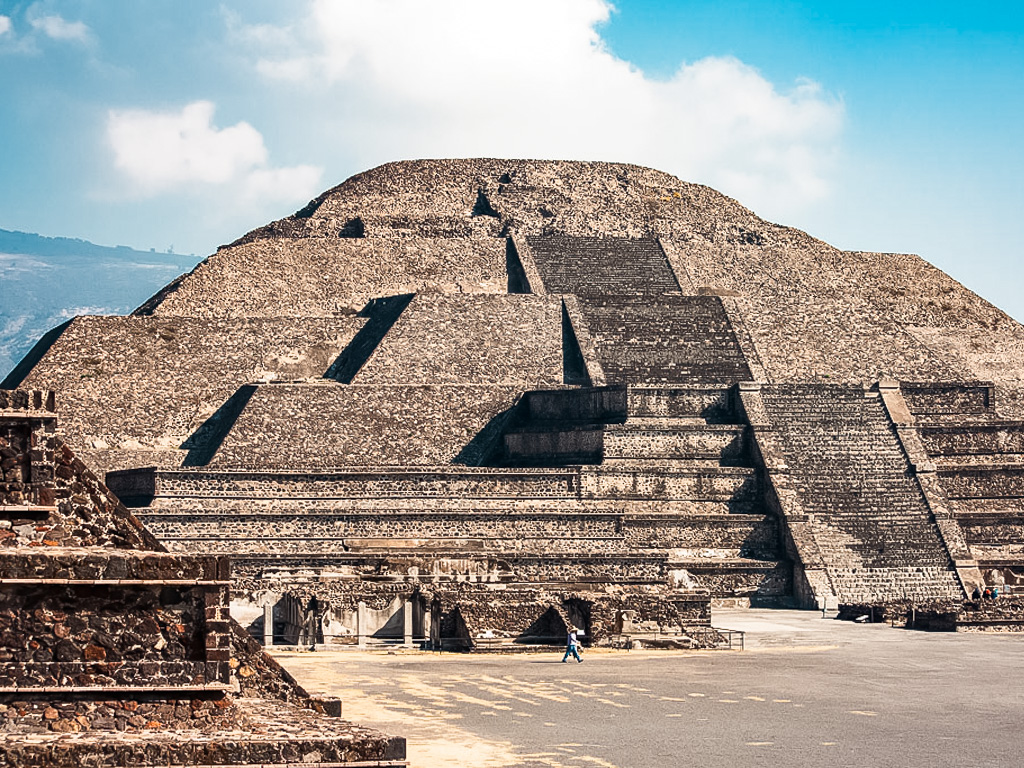
Day of the Dead
Make your Mexico City travel experience more immersive by visiting during the Day of the Dead (Dia de Muertos in Spanish), a UNESCO Intangible Cultural Heritage festival. It is a traditional holiday in Mexico where families to remember their lost ones.
It is believed that on this day, the departed souls of the ancestors make their way back to home. So, every household prepares altars at home, decorate with flowers, candles, salt, water and whatever else their ancestors liked to have in their lifetime. These are called ofrendas, Spanish for offerings. So, do not be surprised if you find a bottle of Coke or a can of beer in these offerings!
But, Day of the Dead is not only about closed family affairs. Throughout the last week of October and first week of November, the entire city gets decked up in Dia de Muertos decorations. Restaurants offer special menus. Areas like Zocalo and Chapultepec Park have big displays of ofrendas. Different groups present parades and the city organizes a grand parade. You can also take a trip to Mixquic to witness the surreal environment of decorations and offerings at the graves behind San Andres church, and how people come together to spend intimate moments with their departed ancestors.
Day of Dead is celebrated on November 2, but the festivities continue from mid October until first week of November. So, if you visit around this time, witnessing the Day of the Dead celebrations is one of the top things to do in Mexico City. You will get to see this vibrant city at its festive best.
Tip: If you wish to visit Mixquic on the Day of the Dead, it may be easier to book a tour. That way, your transport, both ways, will be taken care of. The high traffic and the late hours will not impact your experience. Check this tour for Mixquic, and remember to book way in advance!
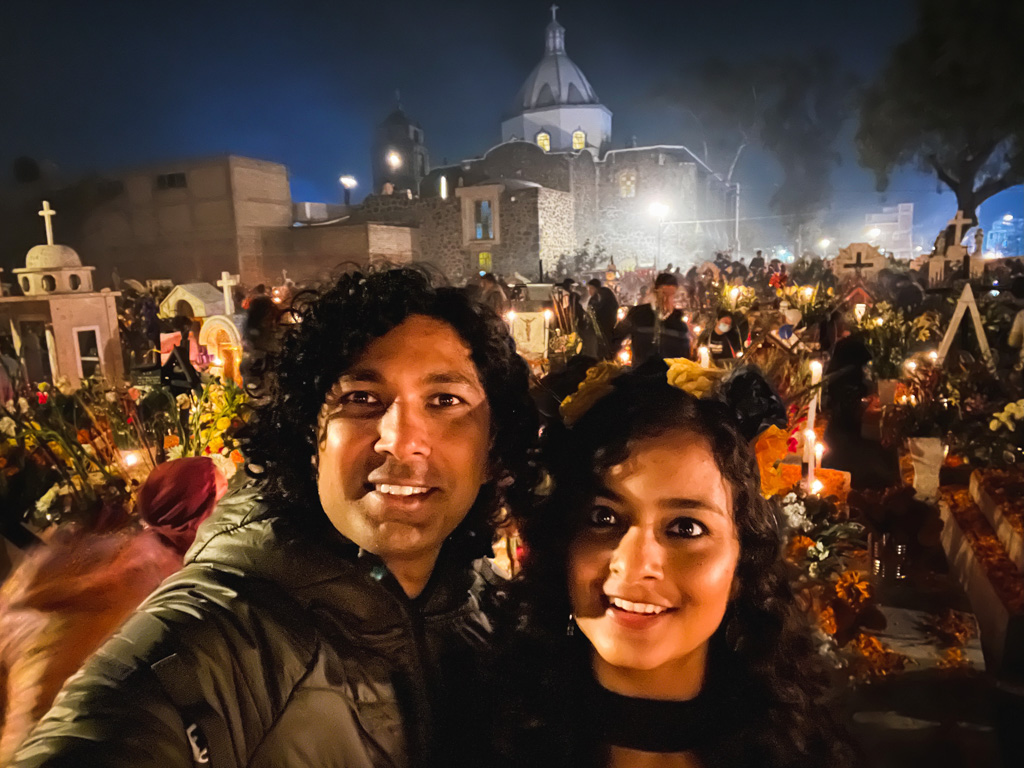
Explore more guided tours by clicking on the widget below:
Where to Stay in Mexico City
From budget hostels to boutique stays, from comfortable apartments to luxury hotels, there are plenty of choices for finding good accommodation in Mexico City. Our suggestion: first zero in on a location/ neighborhood and then start your hotel search. Some of the nicer areas are Polanco, Roma, Condesa and Coyoacan. We also like staying in Zocalo, in the historic center of Mexico City.
Use this Map Search Box below to find a hotel of your choice and budget for staying in Mexico City.
How to Reach Mexico City
Mexico City is well connected with the rest of the world through direct and connecting flights.
Benito Juárez International Airport (MEX) is the major hub with several flights facilitating the passage of millions of passengers every year. A taxi ride from this main airport to the city center takes less than 30 minutes.
In 2022, Felipe Ángeles International Airport (NLU) was inaugurated. However, this airport is located on the outskirts of Mexico City, and a drive to the historic center of the city will take almost about an hour.
If traveling locally between cities within Mexico, consider taking a long distance bus. We have traveled between Oaxaca City and Mexico City by overnight buses from ADO. On all occasions, the bus journeys were on time, safe and comfortable.
Is Mexico City Safe?
Every time we visit Mexico City, we get questions and doubts from well-wishers from around the world if it is safe to visit.
Well, in our personal experience of traveling in Mexico City, we have never felt unsafe.
We have used public transport, including the often dreaded metro. We have walked miles after miles on foot. We have shopped from supermarkets and eaten from street side food vendors. We have brushed shoulders against thousands of people during Day of the Dead parades.
I (Pubali) have also been to Mexico City and traveled on my own as a solo female traveler, on multiple occasions.
Thankfully, we have never had any unpleasant experience while traveling in Mexico City on numerous occasions over the years so far.
Having said that, we strongly recommend never letting your guard down. As with most places in the world, pay attention to your surroundings, stick to the “better” neighborhoods, particularly at night, take care of your belongings, and follow your instincts.
Read this article for more tips about being safe in Mexico City, especially while traveling solo.
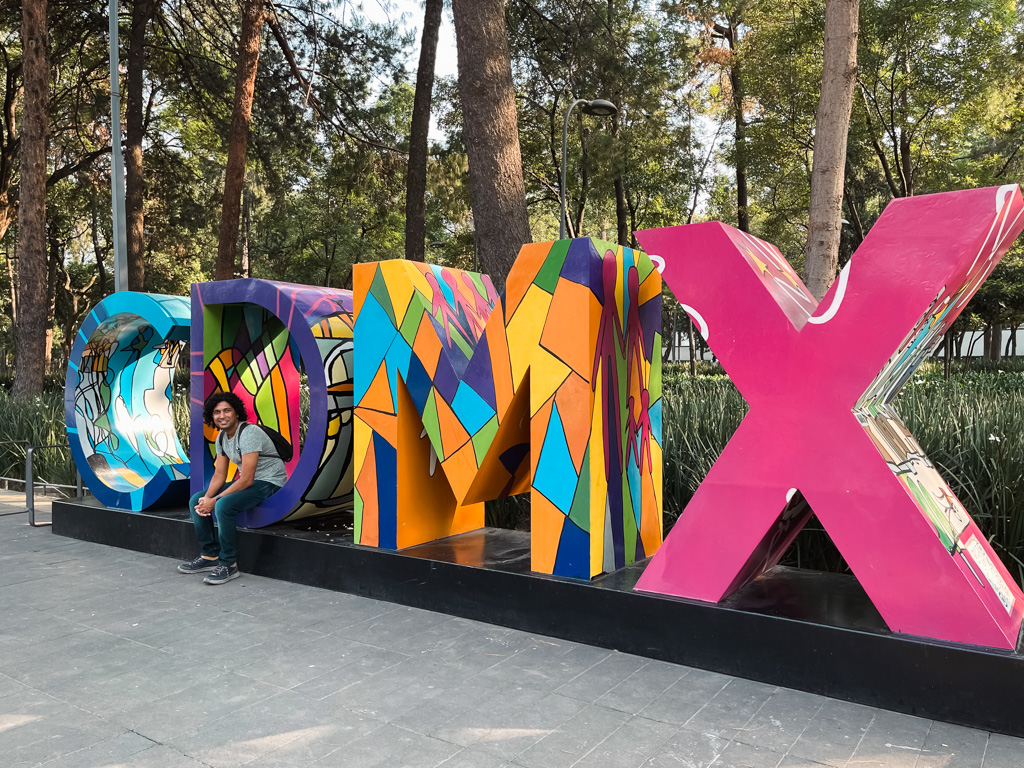
Best Time to Visit Mexico City
Mexico City has 4 distinct seasons:
- Winter: December to February
- Spring: March to May
- Summer and Rainy Season: June to August
- Fall: September to November
The fall weather and the spring weather are pleasant, making the months of March to May, and September to November good times to visit Mexico City. The winter is not harsh either. All you need is a jacket or a sweater to keep yourself warm.
If you do not like rain, avoid planning your Mexico City trip during its summer months of June through August.
For the ultimate combination of cultural immersion and nice weather, visit Mexico City around end of October-early November, during the Day of the Dead week.
Check out our YouTube video of the Dia de Muertos parades in Mexico City.
Final Thoughts
Mexico is a large country that offers cultural and natural diversity across its length and breadth. Naturally, there are dozens of awesome places to visit in the country. Some very popular among tourists, while others remain hidden gems. According to us, Mexico City tops that list!
History, culture, art, food, nature, events, you will never run out of things to do in Mexico City. It is one of the best cities in the whole of Latin America, and possibly even in the world!
Like the post? Pin it!


If you enjoy reading our free travel guides, tips and stories, please consider supporting our work. Thank you.
Travel Planning Logistics
- Accommodation: For several years now, Booking.com has been our platform of choice for booking accommodation while traveling. You can apply all the desired filters and shortlist the ones that meet your criteria. On continued use, you will keep unlocking their Genius benefits. For long term stays, we use Airbnb. Of late, we have also started browsing Hostelworld for finding hostels.
- Tours: When traveling to new destinations, you can plan ahead and book your activities. Check for highly rated tours on Viator and Get Your Guide.
- Packing: From swimwear to sunscreen, hiking pants to insect repellents, buy your vacation packing essentials on Amazon.
- Flights: We always start our flight searches with Skyscanner and Momondo. They are aggregators that display flight options, compiling information across airlines and combinations. What we like the best about these flight aggregators is that you can put “Anywhere” as your destination, so that you find the best flight deals from your city of departure.
Disclosure: Please note that this post may contain affiliate links. If you make a purchase or a booking through these links, we may earn a commission at no extra cost to you. Thank you.
